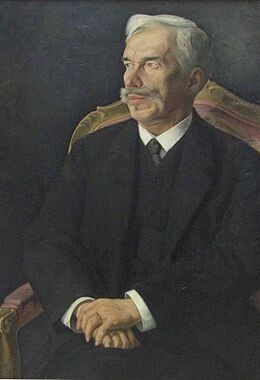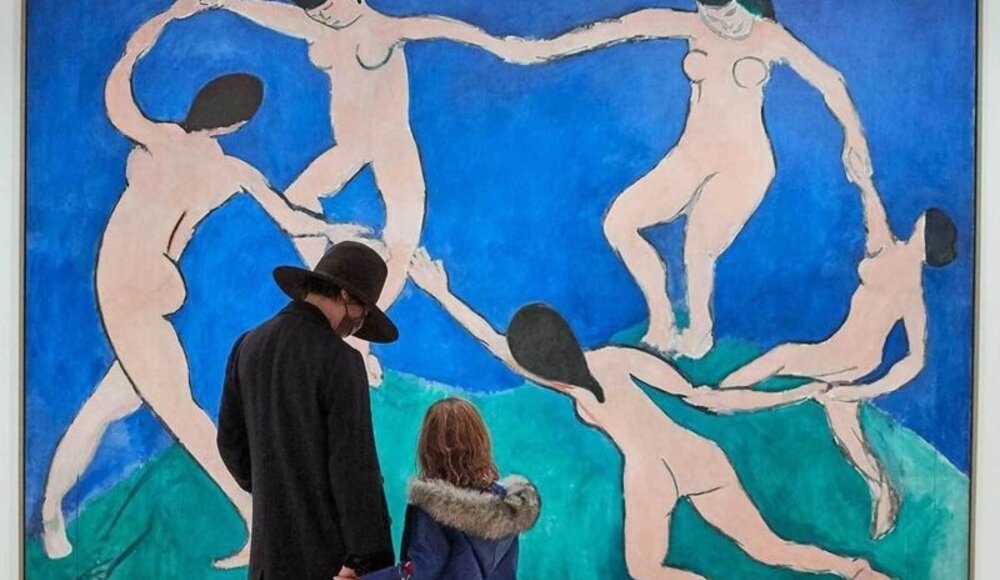An iconic painting that almost never saw the light of day?
It was thanks to Sergei Chtchoukine's passion, vision and commission that La Danse finally saw the light of day.
In this painting, the dancers are stylized and simplified, with clean outlines and shapes that give them a sense of movement and rhythm. They are painted in ultramarine blue, a deep shade that contrasts with the white background of the painting.
The protagonists have different postures, some raising their arms above their heads, others bending their legs slightly or turning on themselves. The artist used oil paint, a technique he was particularly fond of. He also used a pigment called ultramarine blue, which gives the dancers a characteristic blue tint.
In addition to oil paint, he also used gold leaf to add touches of shine to the composition. These sheets were applied to certain parts of the dancers, such as their belts and arms, to make them look more vibrant.
There are two versions of this iconic painting
The first version of La Danse was created in 1909. This version is the better known of the two. This work is now held in the collection of the Museum of Modern Art in New York.
Matisse began work on a second version of La Danse in 1910, which is often referred to as La Danse II.
La Danse II is larger than the first version, with a larger circle of dancers and more dancing figures. The bodies are bigger and more dynamic, with even more vibrant colors and bolder contours. This version is now kept in the collection of the Hermitage Museum, in Saint Petersburg (Russia).
A painting made to be exhibited with another painting
The Dance and the Music are two works of art that were created by the artist in 1910 at about the same time.
The panels are over 3 meters high and were designed to be installed on either side of the fireplace in the bedroom of Russian art collector Sergei Shchukin.
This two paintings are exhibited together at the Hermitage Museum, in Saint Petersburg (Russia)
 Portrait of Sergei Shchukin by Dmitria Melnikova
Portrait of Sergei Shchukin by Dmitria Melnikova
"Dance and Fauvism"
La Danse by Matisse is a work of art that perfectly embodies the artistic movement of Fauvism. This iconic painting is a testament to Matisse's passion for vibrant color and emotional expression in art.
Fauvism was an artistic movement that emerged in France at the beginning of the 20th century. Fauvist artists were known for their bold and expressive use of color, which aimed to create strong and intense emotions in the viewer.
In this work, Dancing Figures are depicted with bright, vibrant colors that evoke the movement and energy of dance. The dancers' bodies are stylized and simplified, with bold outlines and bright colors that immediately grab attention.
A bold, passionate, visionary artist
Matisse was born in Cateau-Cambrésis, in the north of France, in 1869. He studied law in Paris, but quickly abandoned his studies to devote himself to art. He studied under many famous artists, including Gustave Moreau, who was his teacher at the Ecole des Beaux-Arts in Paris.
During his career, he created many iconic works of art, including La Danse, Nu bleu, and La Femme au chapeau. He has also worked in a variety of media including painting, sculpture, printmaking and drawing.
He continued to work until his death in 1954, at the age of 84.
A Fascination for Dance
Dance has always fascinated the artist. Fascination for its beauty and grace, but also for its expressive potential. He saw dance as a way to communicate emotions and feelings that could not be expressed through speech or other artistic means.
This is visible in other works, such as the Nu Descending the Stairs sculpture. This sculpture represents a moving figure, captured in a moment of transition and effervescence. Again, dance is used as a way to express the deepest emotions and feelings.
5 secrets to know about "La Dance"
Matisse's 'The Dance' is one of the French artist's most famous paintings, but did you know it holds a few secrets?
- The dancers are inspired by African culture
The dancers represented in the painting of "the dance" are inspired by African culture, which the artist had discovered during his travels in North Africa. The figures are stylized and simplified, giving an impression of movement and rhythm.
- He created a plaster model of the dance
Before painting the dance for the dining room wall of his friend, the Russian collector Sergei Shchukin, Matisse created a life-size plaster model of the composition. This model was made in 1909 and is now kept at the Musée d'Art Moderne de la Ville de Paris.
- The original dance was bigger
The original version of the dance was larger than the one we know today. It was nearly eight meters long and four meters high, but was scaled down to fit the size of Shchukin's dining room.
- The dance was hidden during the Russian Revolution
In 1917, during the Russian Revolution, "the dance" was hidden behind a brick wall to protect it from looting and destruction. It was rediscovered in 1930 during the restoration of the Shchukin house.
- Dance has inspired other artists
"The Dance" has been an inspiration to many artists, including American choreographer Martha Graham, who created a dance inspired by the painting in 1928. It has also influenced other modern artists, such as Pablo Picasso and Jackson Pollock.


 Selena Mattei
Selena Mattei